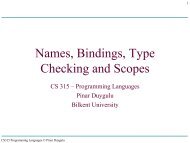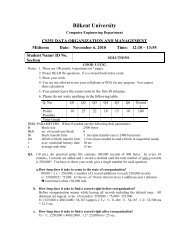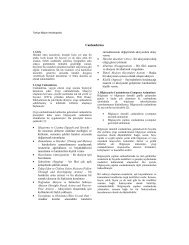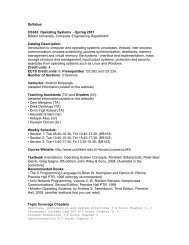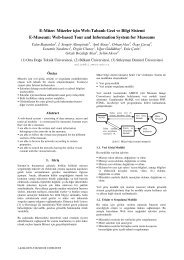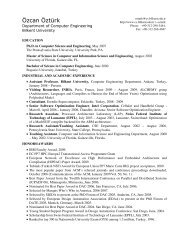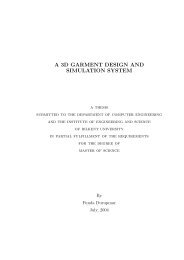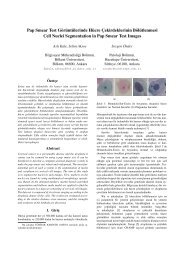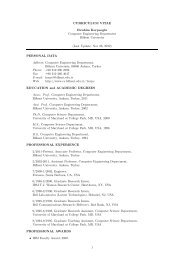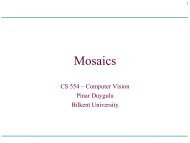On Probability of Success in Linear and ... - Bilkent University
On Probability of Success in Linear and ... - Bilkent University
On Probability of Success in Linear and ... - Bilkent University
You also want an ePaper? Increase the reach of your titles
YUMPU automatically turns print PDFs into web optimized ePapers that Google loves.
ξ1, ξ2, . . . , ξn.<br />
Def<strong>in</strong>ition 2. For 0 < q < 1, the sample quantile <strong>of</strong> order q is the ⌊qn⌋ + 1-th<br />
order statistic ξ ∗ ⌊qn⌋+1 .<br />
Theorem 1. Let ξ1, ξ2, . . . , ξn be <strong>in</strong>dependent, identically distributed r<strong>and</strong>om<br />
variables, with an absolutely cont<strong>in</strong>uous distribution function F (x). Suppose that<br />
the density function f(x) = F ′ (x) is cont<strong>in</strong>uous <strong>and</strong> positive on the <strong>in</strong>terval<br />
[a, b). If 0 < F (a) < q < F (b) < 1, <strong>and</strong> if i(n) is a sequence <strong>of</strong> <strong>in</strong>tegers such that<br />
�<br />
√ �<br />
lim n �<br />
i(n)<br />
n→∞ � n<br />
�<br />
�<br />
− q�<br />
� = 0,<br />
further if ξ ∗ i denotes i-th order statistic <strong>of</strong> the sample ξ1, ξ2, . . . , ξn, then ξ ∗ i(n) is<br />
<strong>in</strong> the limit normally distributed, i.e.,<br />
where<br />
lim<br />
n→∞ P<br />
� ∗ ξi(n) − µq<br />
σq<br />
�<br />
< x = Φ(x),<br />
µq = F −1 (q),<br />
σq = 1<br />
�<br />
q(1 − q)<br />
.<br />
f(µq) n<br />
Tak<strong>in</strong>g i(n) = ⌊qn⌋ + 1, the theorem states that the empirical sample quantile<br />
<strong>of</strong> order q <strong>of</strong> a sample <strong>of</strong> n elements is for sufficiently large n nearly nor-<br />
mally distributed with expectation µq = F −1 (q) <strong>and</strong> st<strong>and</strong>ard deviation σq =<br />
1<br />
f(µq)<br />
�<br />
q(1−q)<br />
n .<br />
2.3 <strong>Success</strong> <strong>Probability</strong><br />
The sample bias <strong>of</strong> the right key, X0 = T0/N − 1/2, approximately follows<br />
a normal distribution N (µ0, σ 2 0) with µ0 = p − 1/2 <strong>and</strong> σ 2 0 = 1/(4N). The<br />
absolute sample bias <strong>of</strong> wrong keys, Yi, i �= 0, follow a folded normal distribution<br />
(see Appendix A) FN (µw, σ 2 w) with µw = 0, assum<strong>in</strong>g a zero bias for wrong keys,<br />
<strong>and</strong> σ 2 w = 1/(4N). We use f0, F0 <strong>and</strong> fw, Fw to denote the probability density<br />
<strong>and</strong> the cumulative distribution functions <strong>of</strong> X0 <strong>and</strong> Yi, i �= 0, respectively.<br />
In an a-bit advantage attack on an m-bit key, success is def<strong>in</strong>ed as<br />
X0 > 0 (5)<br />
X0 > W¯r<br />
where W1, W2, . . . , W2 m −1 are the absolute sample bias <strong>of</strong> the wrong keys sorted<br />
<strong>in</strong> <strong>in</strong>creas<strong>in</strong>g order, <strong>and</strong> ¯r denotes 2 m − 2 m−a . Accord<strong>in</strong>g to Theorem 1, W¯r<br />
4<br />
(6)




